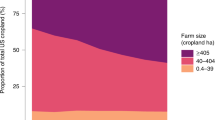Abstract
There is a general belief that federal commodity programs restrict adoption of more sustainable production systems. In the 1990 farm legislation, Congress introduced limited planting flexibility to address these concerns and to reduce federal farm program costs. This program estimates the impact of planting flexibility on selected agricultural sustainability indicators and its policy implications. Results show that planting flexibility is a necessary but not sufficient condition for implementing more sustainable production systems. Other factors such as the availability of economically viable alternatives, macroeconomic conditions, and local resource and environmental concerns need to be considered. Policy reforms can help in achieving economic and environmental gains only in locations with economically viable alternatives. In other cases, increased research and development of new systems are needed to achieve desired results.
Similar content being viewed by others
References
Batte, M.; et al.An Economic Analysis of Sustainable Agriculture Adoption in the Midwest: Implications of Farm Firms and the Environment, SARE/ACE Project Report, Columbus, OH: Department of Agricultural Economics & Rural Sociology, Ohio State University, 1996.
Dobbs, T. L.; Becker, D. L. “Mandatory Supply Control Versus Flexibility Policy Options for Encouraging Sustainable Farming Systems,”American Journal of Alternative Agriculture, 7, 3, 1992, pp. 122–8.
Dobbs, T. L.; Leddy, M. G.; Smolik, J. D. “Factors Influencing the Economic Potential for Alternative Farming Systems: Case Analyses in South Dakota,”American Journal of Alternative Agriculture, 3, 1, 1988, pp. 26–34.
Duffy, P.; Taylor, C. R. “Effects on a Corn-Soybean Farm of Uncertainty About the Future of Farm Programs,”American Journal of Agricultural Economics, 76, 1, 1994, pp. 141–52.
Faeth, P.Growing Green: Enhancing the Economic and Environmental Performance of U.S. Agriculture, Washington, DC: World Resources Institute, 1995.
Faeth, P.; Repetto, R.; Kroll, K.; Dai, Qi; Helmers, G.Paying the Farm Bill: U.S. Agricultural Policy and the Transition to Sustainable Agriculture, Washington, DC: World Resources Institute, 1991.
Gill, M.; Daberkow, S. “Crop Sequences Among 1990 Major Field Crops and Associated Farm Program Participation,”Agricultural Resources: Situation and Outlook Report, AR-24, Washington, DC: Economic Research Service, U.S. Department of Agriculture, 1991, pp. 39–46.
Glauber, J. “Why Aren't Corn Farmers Moving to Soybeans?,”Agricultural Outlook, Washington, DC: Economic Research Service, U.S. Department of Agriculture, June 1988.
Goldstein, W. A.; Young, D. L. “An Agronomic and Economic Comparison of a Conventional and a Low-Input Cropping System in the Palouse,”American Journal of Alternative Agriculture, 2, 2, 1987, pp. 51–6.
Hertel, T. W. “Gainers and Losers with Supply Control: An Economy-Wide Perspective,”Choices, 3, 4, 1988, pp. 10–3.
Huang, W.; Uri, N. D. “An Assessment of Planting Flexibility Policy Options,”Journal of Sustainable Agriculture, 2, 4, 1992, pp. 9–29.
Khan, M. A.; Liang, T. “Mapping Pesticide Contamination Potential,”Environmental Management, 3, 2, 1989, pp. 233–42.
National Research Council.Soil and Water Quality: An Agenda for Agriculture, Washington, DC: National Academy Press, 1993.
Nielsen, E.; Lee, L. “The Magnitude and Costs of Groundwater Contamination from Agricultural Chemicals: A National Perspective,” AER-576, Washington, DC: Economic Research Service, U.S. Department of Agriculture, 1987.
O'Hare, M.; et al.Contamination of Groundwater in the Contiguous United States from Usage of Agricultural Chemicals, Norman, OK: University of Oklahoma Press, 1985.
Painter, K. M.; Young, D. L. “Environmental and Economic Impacts of Agricultural Policy Reform: An Interregional Comparison,”Journal of Agricultural and Applied Economics, 26, 2, 1994, pp. 1–7.
Perry, G. M.; McCarl, B. A.; Rister, M. E.; Richardson, J. W. “Modeling Government Program Participation Decisions at the Farm Level,”American Journal of Agricultural Economics, 71, 4, 1989, pp. 1011–20.
Pollack, S. L.: Lynch, L.Provisions of the Food, Agriculture, Conservation, and Trade Act of 1990, AIB-624, Washington, DC: Economic Research Service, U.S. Department of Agriculture, 1991.
Richardson, J. S.; et al. “Farm Level Impacts of Reduced Chemical Use on Southern Agriculture,”Southern Journal of Agricultural Economics, 23, 1, 1991, pp. 27–37.
Setia, P. P. “Risk Analysis of Planting Flexibility Choices on Rice Farms in the Mississippi River Delta,”Rice: Situation and Outlook Report, RS-63, Washington, DC: Economic Research Service, U.S. Department of Agriculture, 1992, pp. 21–8.
Sun, H.; Bergstrom, J. C.; Dorfman, J. H. “Estimating the Benefits of Groundwater Contamination Control,”Southern Journal of Agricultural Economics, 24, 2, 1992, pp. 15–23.
Taylor, C. R.; et al. “Economic Impacts of Chemical Use Reduction on the South,”Southern Journal of Agricultural Economics, 23, 1, 1991, pp. 15–23.
Tobey, J. A.; Reinert, K. A. “The Effects of Domestic Agricultural Policy Reform on Environmental Quality,”Journal of Agricultural Economic Research, 43, 2, 1991, pp. 20–8.
Ugarte, D.; et al.Economic and Environmental Impacts of Movement Toward a More Sustainable Agriculture in the United States, SARE/ACE Project Report, Knoxville, TN: Agricultural Policy Analysis Center, University of Tennessee, 1996.
Westcott, P. C. “Planting Flexibility and Land Allocation,”American Journal of Agricultural Economics, 73, 4, 1991, pp. 1105–15.
Young, D. L.; et al. “A Methodology for Identifying Social Welfare Maximizing Policies to Promote Sustainable Agriculture with an Application to Variable Landscape Farming in the Pacific Northwest Palouse,” SARE/ACE Project Report, Pullman, WA: Department of Agricultural Economics, Washington State University, 1996.
Young, D. L.; Painter, K. M. “Farm Program Impacts on Incentives for Green Manure Rotations,”American Journal of Alternative Agriculture, 5, 3, 1990, pp. 99–105.
Author information
Authors and Affiliations
Rights and permissions
About this article
Cite this article
Setia, P., Hyberg, B., Ugarte, D.d.l.T. et al. Planting flexibility: Implications for agricultural sustainability. International Advances in Economic Research 3, 299–311 (1997). https://doi.org/10.1007/BF02294916
Issue Date:
DOI: https://doi.org/10.1007/BF02294916




